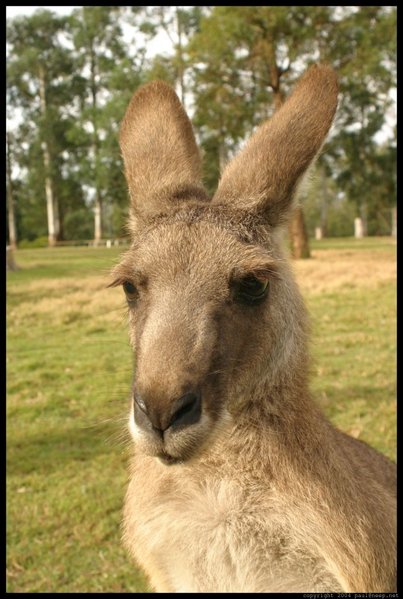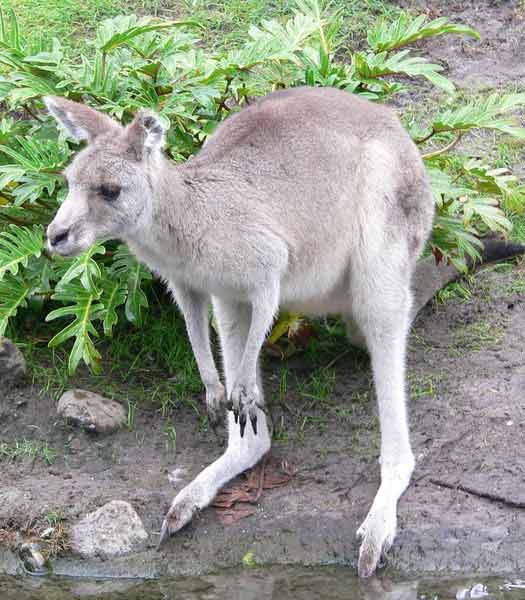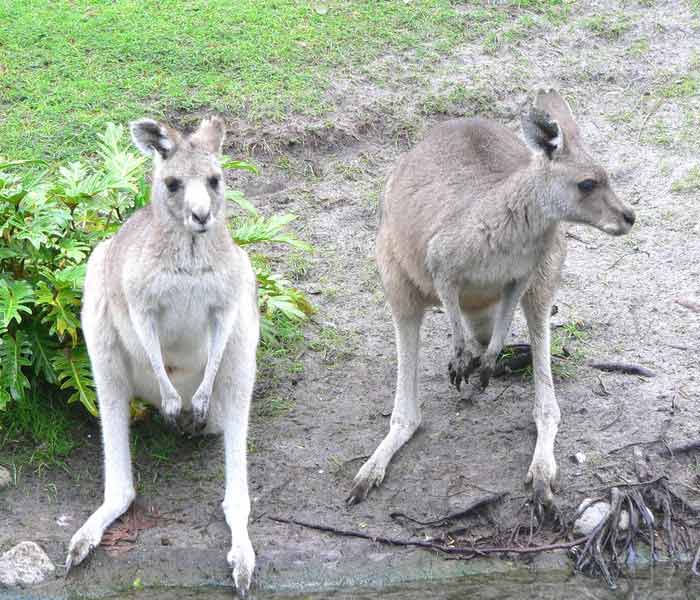 |
usa | world | animals | vocabulary | health | science | math | history |
Kangaroo
A kangaroo is any of several large macropods (the marsupial family that also includes the wallabies, tree kangaroos, wallaroos, pademelons and the quokka: 45 species in all). The term kangaroo is sometimes used in a broader sense to refer to all members of the macropod family. Kangaroos are native to the continent of Australia, while a number of tree kangaroos are found in New Guinea.
The word kangaroo is said to derive from the Guugu Yimidhirr (an Australian Aboriginal language) word gangurru, referring to the Grey Kangaroo. The name was first recorded as kangaru by Joseph Banks on James Cook's first voyage of exploration, when they were beached at the mouth of the Endeavour River in the harbour of modern Cooktown for almost 7 weeks repairing their ship which had been damaged on the Great Barrier Reef.

Kangaroo soon became adopted into standard English where it has come to mean any member of the family of kangaroos and wallabies. The belief that it means "I don't understand" is a popular myth that is also applied to any number of other Aboriginal-sounding Australian words. Male kangaroos are called bucks, boomers or jacks; females are does, flyers, or jills and the young are joeys. The collective noun for kangaroos is a mob.
There are three species:
The Red Kangaroo (Macropus rufus) is the largest surviving marsupial anywhere in the world. Red Kangaroos occupy the arid and semi-arid centre of the continent. A large male can be 1.5 m(4.5 feet) tall and weigh 85 kg(187 lbs).
The Eastern Grey Kangaroo (Macropus giganteus) is less well-known than the red (outside of Australia), but the most often seen, as its range covers the fertile eastern part of the continent.
The Western Grey Kangaroo (Macropus fuliginosus) is slightly smaller again at about 54 kg(119 lbs) for a large male. It is found in the southern part of Western Australia, South Australia near the coast, and the Darling River basin.
Kangaroos have large powerful hind legs, large feet designed for leaping, a long muscular tail for balance, and a small head. They are the only large animals to use hopping as a means of locomotion. The comfortable hopping speed for Red Kangaroos is about 20-25 km/h(13-16 mph), but they can hop as fast as 70 km/h(43 mph) over short distances.

Kangaroos are large herbivores, feeding on grass and roots, and they chew cud. All species are nocturnal and crepuscular, usually spending the days idling quietly and the cool evenings, nights and mornings moving about and feeding, typically in groups called mobs. The life expectancy of a kangaroo is about 18 years.
Kangaroos have few natural predators. One of the major natural predators, the Thylacine, is now extinct. However, humans arrived in Australia at least 50,000 years ago and introduced the Dingo about 5,000 years ago. The use of dingoes, and later hunting dogs by Europeans, to hunt kangaroos has resulted in most kangaroos having an enmity for dogs. The mere barking of a dog can set a full-grown male boomer into a wild frenzy. In extreme circumstances, one or more Wedge-tailed Eagles will attack and sometimes kill a kangaroo (even an adult Red), but only when no more suitably-sized food is available. Goannas and other carnivorous reptiles also pose a danger to the smaller kangaroo species when other food sources are lacking.
Along with dingoes and other canids, introduced species like foxes and feral cats also pose a threat to kangaroo populations, as they do most native populations. Kangaroos and wallabies are apt swimmers, and often flee into waterways if presented with the option. If pursued into the water, a large kangaroo may use its forepaws to hold the predator underwater to drown it.
Kangaroos have developed a number of adaptations to a dry, infertile continent and a highly variable climate. As with all marsupials, the young are born at a very early stage of development after a gestation of 31-36 days. At this stage, only the forelimbs are somewhat developed, to allow the newborn to climb to the pouch and attach to a teat. In comparison, a human embryo at a similar stage of development would be about 7 weeks old, and premature babies born at less than 23 weeks are usually not mature enough to survive. The joey will usually stay in the pouch for about 9 months or(for the Western Grey)or 180 to 320 days, before starting to leave the pouch for small periods of time. It is usually fed by its mother until the age of 18 months.

A female kangaroo is usually pregnant in permanence, except on the day she gives birth; however, she has the ability to freeze the development of an embryo until the previous joey is able to leave the pouch. The composition of the milk produced by the mother varies according to the needs of the joey. In addition, she is able to simultaneously produce two different kinds of milk for the newborn and the older joey who still lives in the pouch.
Kangaroos and wallabies have a unique ability to store elastic strain energy in the tendons of their large hind legs. In consequence, most of the energy required for each hop is provided by the spring action of the tendons rather than by muscular effort. There is also a linkage between the hopping action and breathing: as the feet leave the ground, air is expelled from the lungs; bringing the feet forward ready for landing fills the lungs again, providing further energy efficiency. Studies of kangaroos and wallabies have demonstrated that, beyond the minimum energy expenditure required to hop at all, increased speed requires very little extra effort (much less than the same speed increase in, say, a horse, a dog, or a human), and also that little extra energy is required to carry extra weight. For kangaroos, the key benefit of hopping is not speed to escape predators — the top speed of a kangaroo is no higher than that of a similarly-sized quadreped, and the Australian native predators are in any case less fearsome than those of other continents — the benefit is economy: in an infertile continent with very variable weather patterns, the ability of a kangaroo to travel long distances at moderately high speed in search of fresh pastures is crucial.
A sequencing project of the Kangaroo genome was started in 2004 as a collaboration between Australia (mainly funded by the State of Victoria) and the NIH in the USA. The genome of a marsupial such as the kangaroo is of great interest to scientists studying comparative genomics because marsupials are at the right "distance" from humans: mice are too close and haven't developed many different functions, while birds are already too far away. The dairy industry has also expressed some interest in this project.
This article is licensed under the GNU Free Documentation License. It uses material from the Wikipedia article "kangaroo".